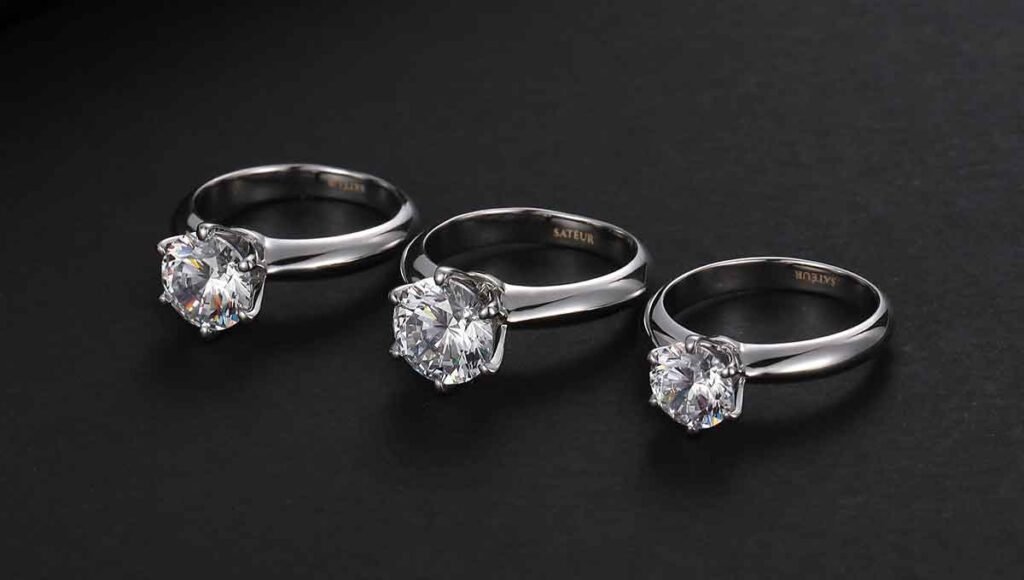In 1948 when he had a monopoly of natural diamonds, De Beers said, “Diamonds are forever.” Things have changed since then. The sales of his kind of diamonds are sinking, while that of diamond alternatives are rising.
As proof that natural diamonds aren’t forever, a 2019 Global Diamond Report projected a 25% decline in rough diamond sales and 10% of polished stones. The major factors causing this decline are lab-grown diamonds and the growing consumer demand for environmental and social responsibility. Not to mention the fact that diamond buyers have started feeling the pinch of expensive natural diamonds on their pockets.
So what is a diamond alternative?
Due to the various diamond hues in the market, the term “diamond alternative”could mean differently to different people. To clear the air, natural clear diamonds—the favorite gemstones for engagement (like the one in this A. Jaffe Solitaire Engagement Ring review) and wedding rings—are the basis of comparison for these alternatives.
And this is for a very good reason—the market for engagement rings in the United States is growing at an average of 5% per year. While diamonds are still hanging on, alternatives are slowly eating a piece of its pie each day.
Six Top Diamond Alternatives
The market for engagement rings is dominated by millennials. While they may have the money to splurge on expensive items, they are also a practical bunch. They are just starting on with their careers and are careful in their expenses. They know that diamond alternatives can be just as attractive as natural diamonds, yet cheaper. Besides, younger generations are more focused on the emotional value of the ring, not its price tag.
So read on to know what these diamond alternatives are.
Lab-created Diamonds
In 1954, when General Electric first made diamonds in the lab. That even made De Beers’ “Diamonds are forever” quote lose its luster.
They became commercially available in the 70s and gained popularity in the 80s – when high-quality synthetic diamonds became available.
Lab-created diamonds eliminated the long and expensive process of digging up tons of dirt to create that tiny glitter on a ring, or a pair of earrings.
Yet, they are anatomically the same. Synthetics are just as hard as natural diamonds, They are as clear and as brilliant. You cannot tell the difference in the glitter between them. Unless you take it to the certified lab, you cannot differentiate one from the other.
The huge difference is in the price. Lab-created diamonds are often half the price of natural diamonds of the same carat size.
Lab-grown diamonds are made using either of these two processes:
- HPHT (High Pressure/High Temperature): in this process, a small diamond seed is placed into a piece of carbon. Then, using a press, it is compressed to 1.5 million pounds per square inch pressure, and heated to 2,700 deg F. These conditions will slowly melt the carbon, forming a diamond around the initial diamond seed. The newly-formed carbon is then carefully cooled
- CVD (Chemical Vapor Deposition): this method also uses a small carbon seed placed inside a sealed chamber filled with carbon-rich gasses like methane and hydrogen. Then the chamber is heated to 1,400 deg F, and the gasses are then ionized into plasma. This process breaks down the molecular bond of the gasses. Once broken, pure carbon begins to stick to the carbon seen, forming another diamond.
Moissanite
This diamond substitute moissanite was discovered by French scientist Henri Moissan in 1893. While scouring a meteor crater in Canyon Diablo, Arizona, U.S.A, he stumbled upon some rocks that caught his attention.
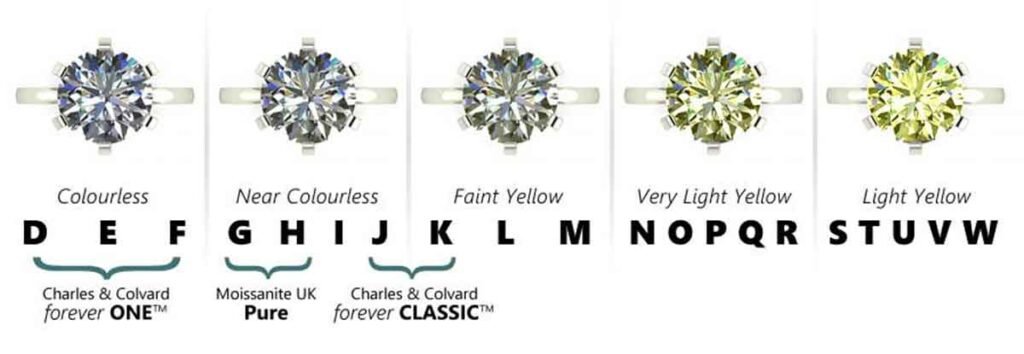
At first, he thought they were diamonds. Then in 1904, he identified his find as silicon carbide, not carbon.
Now, if you’re wondering what’s the closest thing to a diamond, the answer is moissanite.
To give you a clearer idea of this moissanite vs diamond, here’s a brief rundown:
Customer preference:
As of 2017, moissanite rings had officially dislodged diamonds in the engagement ring niche. Moissanites make great stones for rings because they are white, have a great sparkle, and come in a variety of shapes and sizes.
Price
This is the most appealing quality of moissanite. It costs a fraction compared to that of a diamond of the same carat size.
For example, depending on quality, 1-carat moissanite can cost around $ 650, while a diamond could cost $ 5,000.
Durability
Moissanite gems are very durable. Next to diamonds at 10 in the Mohs hardness scale, moissanite is at 9.5. This makes moissanite jewelry items great for daily wear.
Visual appeal
If put side by side, moissanite gives off more fire and spectral colors than a diamond; they are more brilliant. Moissanite emits more colorful flashes of light than a diamond because it has a higher light dispersion rate, 2.65, against that of a diamond which is at 2.4.
Color
Moissanites are considered “colorless.” But when compared to diamonds in the D (colorless) of the GIA color rating sale, they will appear more colored, but not as bright.
So, is moissanite a good diamond alternative? You bet, it is.
Take note, however, that moissanite is a very rare gem, so what you can find in the market is more likely lab-grown, too.
Cubic Zirconia
While the previous two diamond alternatives have naturally occurring counterparts, cubic zirconia has none. Oh, there is a cubic zirconia mineral, but it has nothing to do with cubic zirconia, the gem.
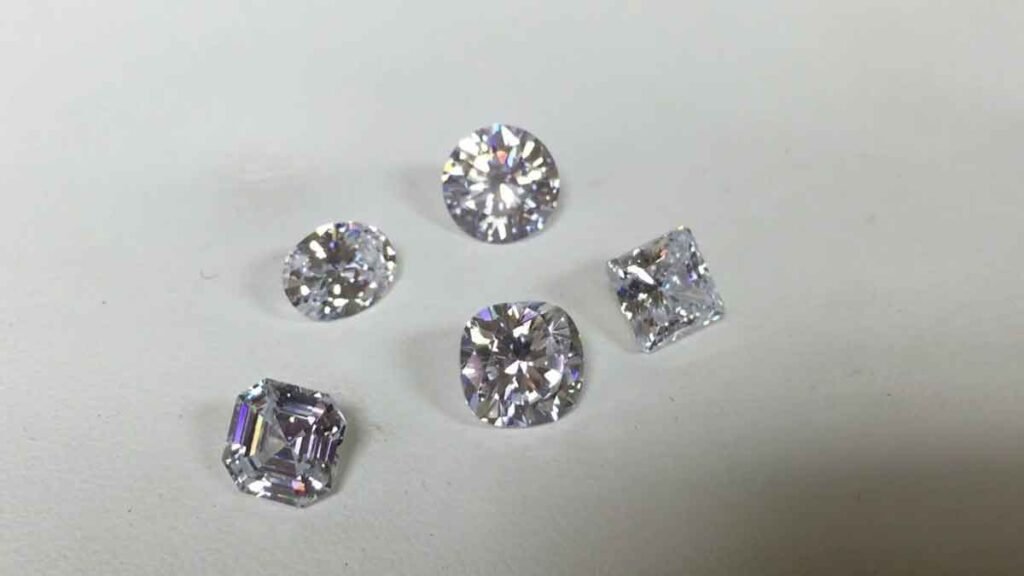
Cubic zirconia is a lab-grown zirconium dioxide first discovered by German mineralogists von Staclzelberg and Chudoba. The two discovered that melted zirconium dioxide contained cube-shaped crystals. But they found no practical application for it at that time, so it was shelved.
Then in the 1960s, when scientists searched for cheaper materials to be used in lasers and other industrial applications, like creating lab diamonds, the single-crystal cubic zirconium was given a second look. This led to cubic zirconium becoming a diamond alternative.
As demand grew, so was the need to manufacture more. That prompted a Russian scientist to invent a process of creating synthetic cubic zirconium. He named his product Djevalite. It immediately caused a stir in the jewelry market. And its popularity was given a boost in 1980 when diamond alternatives became fashionable.
But how did Djevalte become cubic zirconium or CZ? That credit is given to Swarovski – a world-renowned maker of fine lead jewelry who created his own version of Djevalte and called it cubic zirconium or CZ, for short.
Cubic zirconia facts
- CZ is softer than moissanite at 8.5 on the Mohs scale compared to diamonds at 10
- it is heavier than diamond on a per carat basis, but not as hard.
- when shopping for a CZ, the shopowner may give you its carat weight and call it a diamond equivalent.
- CZ can be cut into shapes like that of a diamond and other colored gemstones.
- a white CZ is colorless – with none of the inclusions found in untreated diamonds.
- it produces more flashes of color than a diamond
- some of the CZs in the market are coated to make them more durable but lessens their “fire.”
- It is the cheapest of all diamond alternatives.
White Topaz
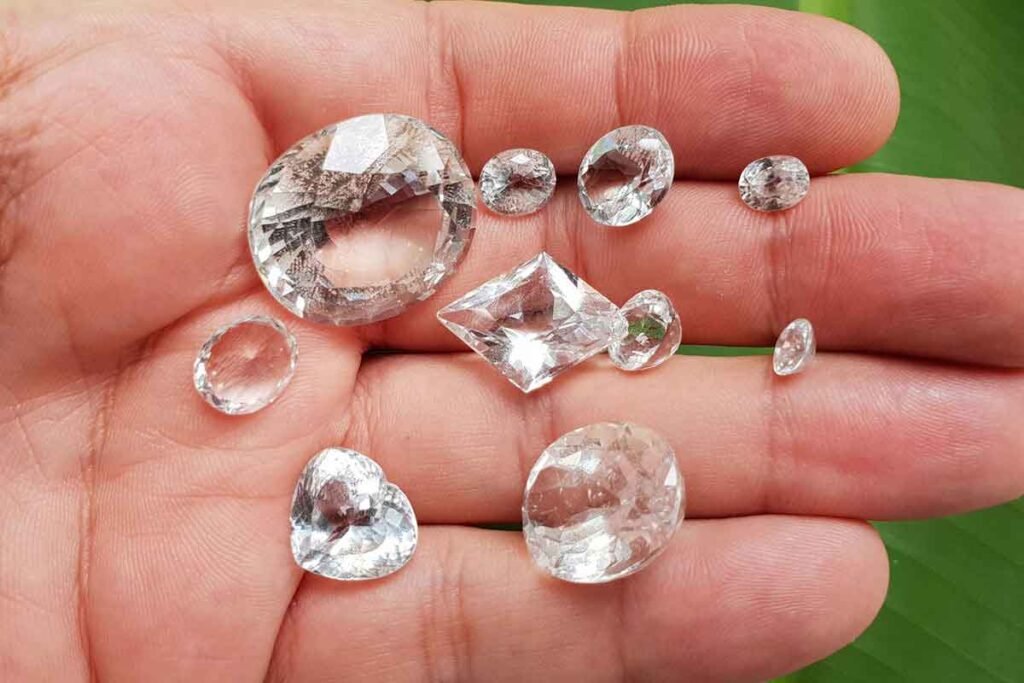
Size
Large diamonds are more expensive because they are rarer. White topaz, on the other hand, prices go down as sizes go up. This is because there are more chances of imperfections in larger stones.
Color
Both white topaz and diamonds are similar in this aspect. And both are affected by impurities. What makes white topaz different is that its color looks more natural than a diamond’s.
White Sapphire
White sapphire is one of the top diamond alternatives due to its lack of color and lower price. As a ring, it can easily pass for a diamond. It ranks third on the Mohs Scale, at 9, which is perfect for engagement and promise rings.
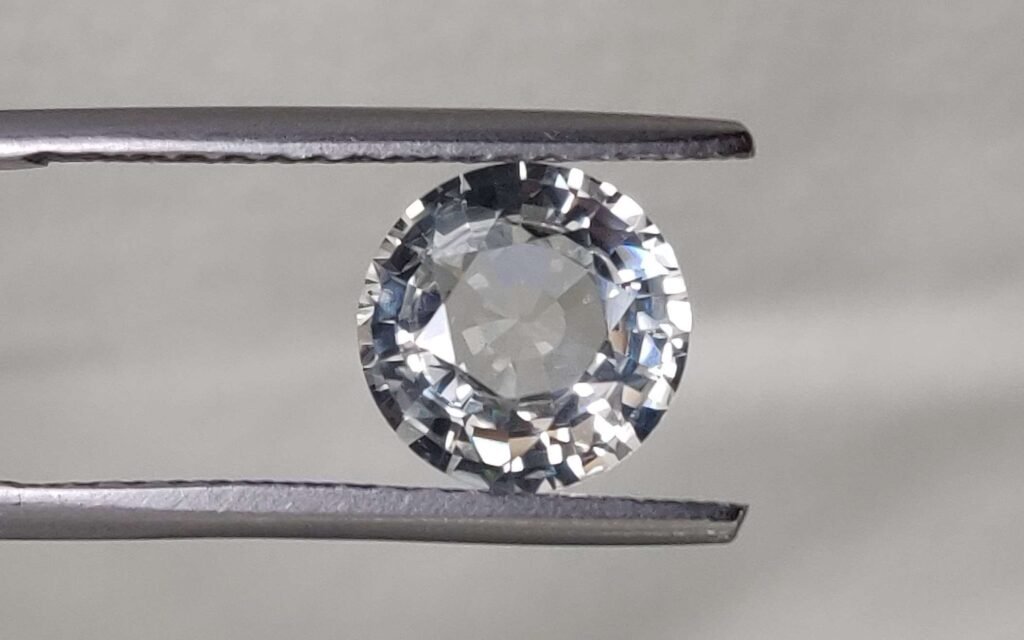
This gemstone belongs to the corundum family, like ruby, without trace elements.
And how does it fare against a diamond? Read on…
Visual appearance
Of course, there’s a huge difference between how they look. Diamonds are more brilliant and fiery, while white sapphire would appear silvery or cloudy.
Compared to a diamond, cubic zirconia, and moissanite, and white sapphire gives off a muted silvery sparkle. And it is heavier.
Sparkle
White sapphire’s sparkle is silvery-white to gray, while that of a diamond is rainbow-colored mixed with some streaks of white. This is because diamonds have higher reflective and dispersion indexes—both are measures of how a gem handles light.
Because of these properties, diamonds still sparkle even with a slight cover of dirt or grime, while white sapphire needs more constant cleaning.
Color
Compared to a colorless diamond, white sapphire is not as colorless. Its body color can be cloudy or milky, which makes it appear dull and unattractive. Hence, extra effort must be spent in looking for a truly colorless gem to make your purchase worthwhile.
Price
When it comes to price, white sapphire is the thumbs-up winner over diamonds. But don’t rule it out when buying a colorless jewelry item. For its price, it is still elegant, durable, and for people looking for huge stones on their engagement rings, white sapphire is the best fit.
Opal
Appearance-wise, opal does not look like a diamond. Not even close, Yet it ranks high in the diamond alternatives list. Do you know why?
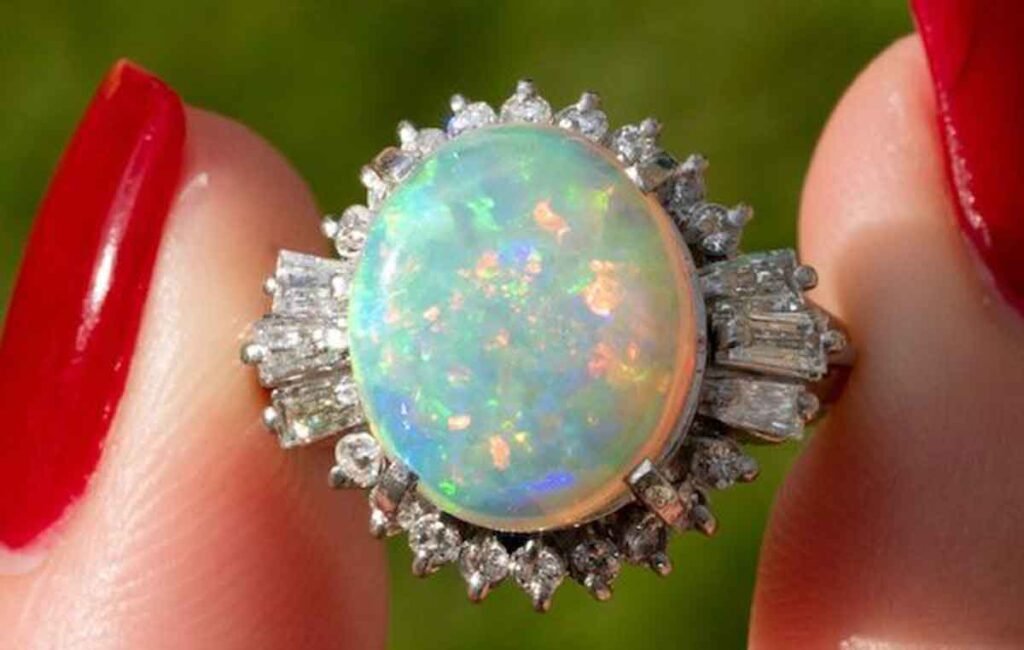
To get the answer, it is necessary to know what opal is.
Opal is a non-crystalline form of silica. Ironically, it is related to more crystalline minerals like quartz or agate. It is formed from amorphous (without a clearly defined shape or form) lumps of silica rather than from naturally faceted crystals.
Is opal worth it?
The most common body color of opal is white, but there are other colors as well, like yellow, grey, black, or brown. Because of this, opal engagement rings have become the preferred choice of bohemian types and millennials—those who scorn conventional thinking and want to be different and unique; to make a statement.
They may not sparkle, but they are cheap. And their display of colors can bedazzle anyone who is artistically inclined.
Whatever they lack in brilliance, is more than compensated by their astonishing display of colors—the more intense they are, the more brilliant the stone is.
And for people who want to be truly unique, opal is the best choice because they are always different. No two stones are exactly the same.
Now that you have a brief rundown of the top diamond alternatives, things are more confusing than ever, right? It makes you feel like asking “what stone looks the most like a diamond?”
The answer is pretty obvious, isn’t it? Lab-grown diamonds.
Diamonds have always been a symbol of love, romance, commitment. And this is embodied in the Greek word Adamas, which means unconquerable in English. While it may still be unconquerable, it is facing a daunting challenge from diamond substitutes.
For price reasons and sustainability, more and more people are turning to lab-grown substitutes, which indeed are worthy to be called “the other stones.” And these are not just ordinary people looking for a bargain. They include celebrities like Penelope Cruz, who champions lab-created gems, and Meghan Markle, the Duchess of Sussex.
Men do not flaunt their jewelry as much as women, but Leonardo de Caprio is a big investor in the synthetic jewelry industry.
